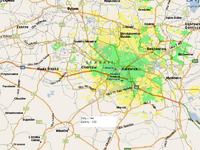Recently, with a friend, I tested the range of Nagoya 666 antennas on Yaesu VX3 and ICOM IC E90 radios.
I performed the test in a city in a heavily built-up area in Silesia. Both radios were outdoors. On the 2m band we could barely hear each other after about 1km, after changing the frequency to 70cm we could talk comfortably up to about 4-5km.
If I had base antennas with the same gain for the 70cm and 2m bands mounted on the roof at the same height, which band would I get a greater range with the same power?
I performed the test in a city in a heavily built-up area in Silesia. Both radios were outdoors. On the 2m band we could barely hear each other after about 1km, after changing the frequency to 70cm we could talk comfortably up to about 4-5km.
If I had base antennas with the same gain for the 70cm and 2m bands mounted on the roof at the same height, which band would I get a greater range with the same power?



